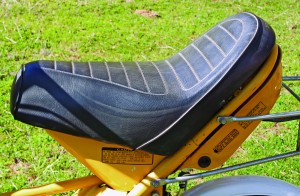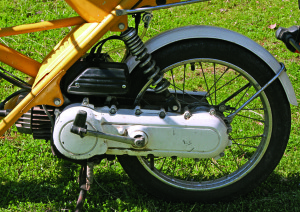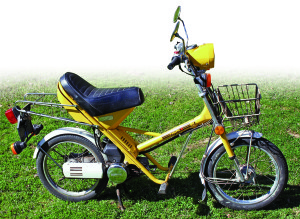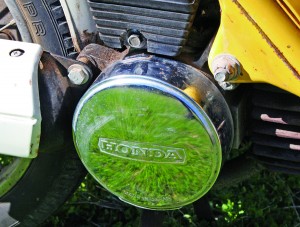When the price of gasoline rose to 60 cents a gallon back in 1976, Honda figured it had a whole new market. Americans were approaching panic status at the thought of spending more than 10 bucks to fill up the tank of that Buick or Dodge.
OPEC (Organization of Oil Exporting Countries) had us over the proverbial barrel—it just happened to be full of oil this time around—and could bleed us dry. We needed more efficient ways to get around town, get the groceries.
Honda wanted to attract new buyers with something different. Economy-minded folk who wanted to get upwards of 100 mpg. And spend less than $400 for the vehicle.

Variations on the famous Cub—on which you meet the nicest people—had been around for donkey’s years, so the marketing fellows thought that a new look would be in order to appeal to the new buyer. Which, though the designers could hardly admit to this sexist approach, would be a woman.
Make the Express look harmless, non-intimidating. And light of weight, so it could be pushed around like a bicycle. Make it so easy to operate that it would appeal to the person whose sole experience on two wheels had been a single-speed bicycle. To enhance the bicycle motif, the designers did away with any minor bodywork, leaving a frame, a discreetly hidden engine and two wheels. And they did not want to burden this new buyer with pedals—they wanted a noped—no pedals. A bike was much more comfortable to ride with both feet on equally placed pegs. Please, nothing complicated like a gearshift. Simplify, with a throttle and two hand levers. And the price must be low.

The frame was a neat assembly of a couple of tubes, with the look of a step-through bicycle, a simple tube coming down from the steering head, then up to support the single seat—no passengers for this noped. Scooter technology was apparent in the drivetrain, with the engine, transmission and rear drive all incorporated in a single-sided swingarm. With a weight of a mere hundred pounds, even the weakest could pick up the Express should it fall over.
The powertrain was not a problem, as Honda had shelves filled with motors. Cheap and simple would be a two-stroke, with nothing but three basic moving parts. A 40mm bore and 40mm stroke would equal an insurance-friendly 49cc. And three ports to allow the fuel to circulate from crankcase to combustion chamber, with an intake, a boost/scavenger and an exhaust. No problem with the messy job of mixing gas and oil, as the little tank over the rear wheel had separate fillers—just don’t confuse them.

This was not a conventional two-stroke, mixing oil and gas in the 12mm carburetor and passing the fuel through a reed-valve, lubricating all the moving parts with the mixture. Instead, Honda utilized a separate oiling system, employing a crankshaft-driven plunger pump which used engine speed and load to inject the right amount of oil into the manifold, not the carb, to make sure the moving bits and pieces in the engine were properly lubricated.
Then the oil would go up the scavenging port to be burned in the combustion chamber. Rev this little 1/20th-liter engine with a 6.5:1 compression ratio up to 7,000 rpm and it would make over four horsepower…4.5 on the dyno.
A simple single-speed, constant-velocity transmission, using a centrifugal clutch, passed the power via a chain back to the rear wheel, with everything fully enclosed. No fuss, no mess, not even any chain adjustment required, as there was an automatic adjuster.

Building cheap and light came with a price—like no electric starter. Honda had introduced Americans to the joys of the electric leg, but this was not considered necessary on the Express. Two dainty dabs at the non-kickstarter over on the left side would wind a spring, like a clockwork mechanism, then you pulled in the left handlebar lever to release the spring, which activated the starter, and putt-putt-putt…the engine started. And since that left handlebar lever also applied the rear-brake lever, the Express was not going anywhere, even if the engine were exceeding 2,500 rpm, when the weights in the automatic clutch would begin to contact the outer drive shell.
This was about as unthreatening a starter mechanism as could be imagined. Very convenient, very simple and very cheap. The owner’s manual warned the would-be mechanic to “never disassemble” the starter-spring mechanism, as the spring could “pop out in a dangerous manner.”
The little 6-volt electrical system used breaker points, and enough of a battery to keep the lights lit, the horn beeping and the feds happy.
Suspension could charitably be called unsophisticated, with the swingarm pivoting below the seat using a single spring unit absorbing whatever shocks might come up on the way to the grocery store. No damping was to be found on the front fork. This was definitely an urban vehicle, not intended for work outside city and town, with an advertised 25 mph top speed. Small internal-expanding brakes were found on both 14-inch wheels, lever operated—left lever, rear brake; right, front. Wheelbase was a short 41 inches.

One obvious shopping asset was the option of a big basket below the headlight and over the front wheel. Perhaps it was not a good place to carry the weight of a case of beer, but very suitable for a normal day’s shopping. And the rear rack was also package friendly, with the help of a couple of bungee cords.
In 1979, the companion Express II model appeared, with slight adjustments to the chassis; a bigger, more comfortable seat; and the gas/oil tank relocated under the saddle. The footpegs were placed a little farther forward, giving it a mildly cruiserish riding style—much the vogue back then. In 1980, turn signals and a bigger battery were added. And the engine dropped the plunger-pump design, reverting to the simpler mixing of oil and gas in the carb. Also, a two-speed transmission that shifted automatically was put in the Express II to help on any hills. In 1981, changes included a CDI ignition, an automatic choke and a genuine kickstarter—apparently customers were not enthralled with the wind-up concept, and kicking over a 50cc two-stroke was no more arduous than winding up the spring.
For 1982, the Express II was gone, the two-speed Express remaining with a bigger saddle and a nifty grocery rack.
But the charm was gone. Americans were accepting the continuous increase in gas prices, and willing to pay for 15 mpg. And a moderate economic recession beginning in 1983 left a lot of unsold Expresses in the stores.
(This Retrospective article was printed in the February 2013 issue of Rider magazine.)








2021 now and I am restoring two identical 79’s I have had in storage foe 20 years just for fun. I ride a Harley touring with 103 cubic inches so this will be way different for running to town or taking it with us in the motorhome. I’m having a tough time getting the headlight unit, mine are broken and possibly salvageable. They were stolen and the fuel tanks removed but I found a couple different color. Wish me luck and email me if you know of any for sale for their parts ( freedomrider777@yahoo.com ).
Here in the UK, spring of 2022, petrol (gasoline) prices are at $9 USD per gallon…
I currently own a 1981 NA50 Express ll in the color red I forget the specific red it is it starts with an m it is the original paint job funny thing is it’s older than I am by at least 20 years I’m 28 I currently got it a guy on Facebook it works all original the only thing that is not original on it is the front headlight currently looking for a ignition cable because I feel like it’s going to be a problem having problem kick starting it sometimes and I’ve already replaced the carburetor so the only other thing I can think of is the ignition cable needs to be replaced so if anybody knows where I can get a condition cable please feel free to contact me at 239-396-0170 and please no BS I am only interested in people with a legit source because I’ve had people contact me before trying to buy it and asking me you know in my parting out no I am only looking for a new or used ignition cable that can work on my 1981 NA50 Express ll if anybody can help that would be great thank you
Have you tired Treatland.tv or Go Power Sports, and of course eBay and Amazon